The Best Flowers For a Bee-Friendly Garden
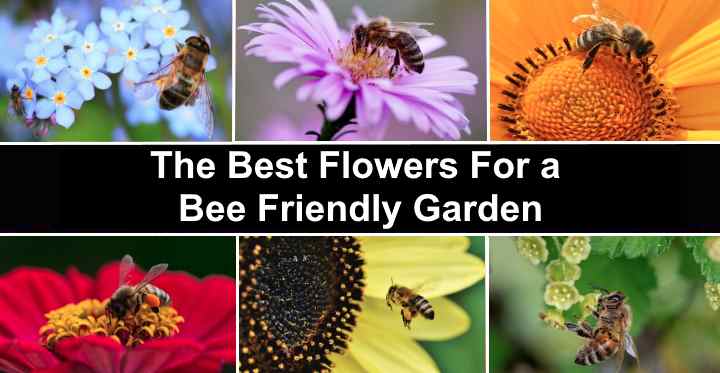
Flowers in a bee garden attract important pollinators to your yard. Not only do bee-friendly flowers add color and beauty to your outdoor space, but they also play a crucial role in local ecosystems. By knowing the right bee-friendly flowers to grow, you can support populations of black and yellow honeybees, bumblebees, carpenter bees, and many other insect species in the suborder Apocrita.
Creating a bee-friendly garden involves choosing the right flowers to attract these important winged insects. Flowers like coneflowers, bee balm, phlox, sunflowers, and lantanas can make all the difference in attracting bees. Also, flowering herbs for bees can help entice a wide range of pollinators and fill your yard with pleasant aromas.
This article is a guide to the best flowers for a bee-friendly garden. Descriptions and pictures of flowers bees love will help you choose the best ones to create an attractive and vibrant outdoor space that is a “hive” of activity in spring, summer, and fall.
The Main Elements of a Bee Garden
A successful bee garden should have several main elements to attract and support bee populations. First, it’s best to plant a wide range of flowers that bloom at different times throughout the year. Also, include a variety of flowers in various colors, especially purple, white, yellow, pink, and blue.
In addition to planting native bee-friendly flowers, creating the right protective environment for bees is crucial. For example, you can set up “bee hotels” in your backyard for mason bees and leafcutter bees. Also, a mix of perennial and annual flowers, herbs, and small ornamental flowering trees can help ensure abundant bees in your yard.
Finally, providing fresh water and avoiding chemicals in your garden can also help bees thrive. Creating a buzz of activity in a bee garden requires a little planning and effort. Still, the payoff is beneficial for both bees and the environment.
How to Choose Plants for a Bee Garden
The best plants for bees in a front or backyard are nectar-rich, colorful flowers that grow in clusters. It’s best to plant blue or purple flowers as they naturally attract honeybees, carpenter bees, and bumblebees. Additionally, bees prefer single blooms because they provide easy access to pollen and nectar.
Purple coneflowers, sunflowers, and bee balm are the best flowers for attracting bees. Because many herbaceous plants have purple flowers, flowering herbs like sage, lavender, and rosemary provide the perfect feast for bees. Also, pink-purple-flowering trees like redbuds have curb appeal and support healthy bee populations.
The Best Flowers For a Bee Garden
A bee garden should have a variety of bee plants with flowers that bloom at different times of the year. So, what are the best flowers bees love that will draw them to your yard? Please read on to find out in this list of flowers for bees.
Purple Coneflower (Echinacea purpurea)
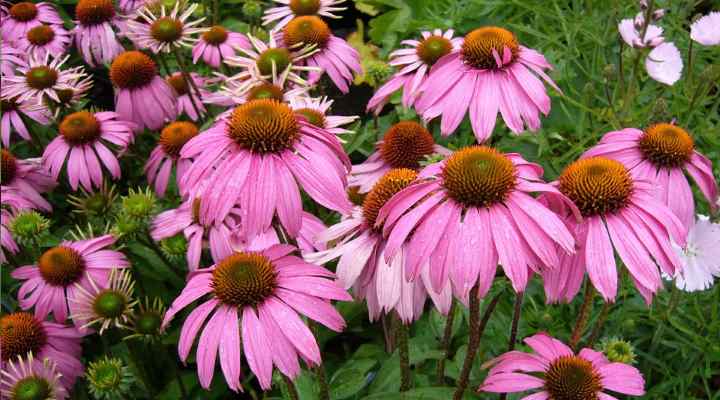
Purple coneflowers are a fantastic addition to a healthy bee garden. These nectar-rich flowers are a favorite of bees due to their vibrant purple color and wide landing pad. The attractive tall flowers for bees are identified by their large drooping petals, cone-like center, and erect stems 2 to 5 ft. (0.6 – 1.5 m) tall.
Purple coneflowers bloom through summer and early fall, making them great flowers for bees at the season’s end. The purple-flowering plants thrive in full sun and a wide range of soil types—from well-drained to poor soils. And the hardy plants are tolerant of heat, drought, and humidity.
Purple coneflowers are a top choice to create a garden full of favorite flowers for bees in USDA zones 3 to 8.
Black-Eyed Susan (Rudbeckia hirta)
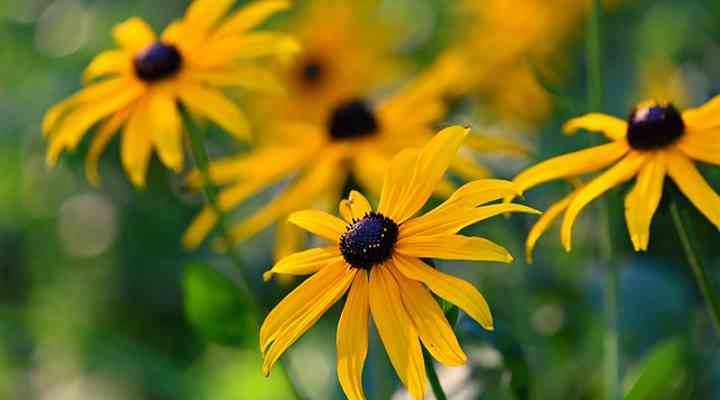
Black-eyed Susan is a stunning yellow-flowering plant suitable for bee-friendly gardens. Attracting bees and butterflies, this plant produces beautiful golden-yellow blooms with dark conical centers that provide abundant food supplies for bees and pollinators. The large yellow daisy-like flowers measure 3” (7.5 cm) wide and grow 3 ft. (1 m) tall.
Black-eyed Susan is a flowerbed staple to attract social and solitary bees. The hardy perennials bloom from mid-summer through fall, providing a food source for bees during a critical time in their annual life cycle.
A key benefit of black-eyed Susans flowers in a bee garden is their ability to attract short- and long-tongued bees. These blooms provide sweet nectar and a plentiful source of food for a wide range of bee species. In addition, black-eyed Susans are native to North America, making them an ideal choice to incorporate native plants into bee gardens.
Suitable for USDA zones 3 to 10.
Marsh Blazing Star (Liatris spicata)
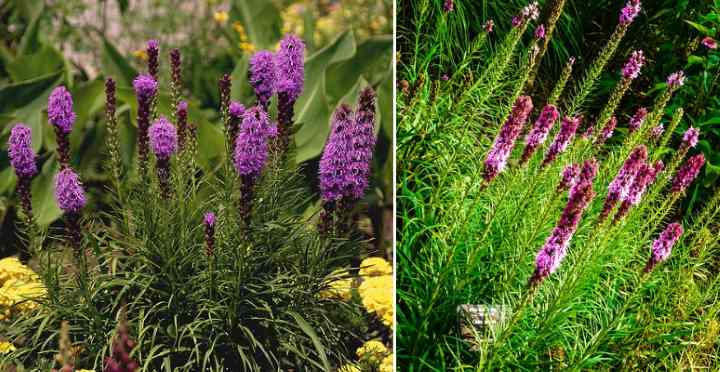
Marsh blazing star is a great flower when it comes to attracting honeybees and bumblebees to your garden. This beautiful perennial ornamental plant boasts stunning purple flowering spikes with button-shaped pink, red, white, or purple flower clusters.
The erect flower spikes grow 4 ft. (1.2 m) tall and bloom for four weeks in late summer, making it an excellent addition to a fall bee garden.
Marsh blazing star is native to North America, and its sweet nectar is an important source of food for honeybees. The erect flowering spikes also add a splash of color late in the season, where they thrive in full sun in USDA zones 3 to 10.
Wrinkleleaf Goldenrod (Solidago rugosa)
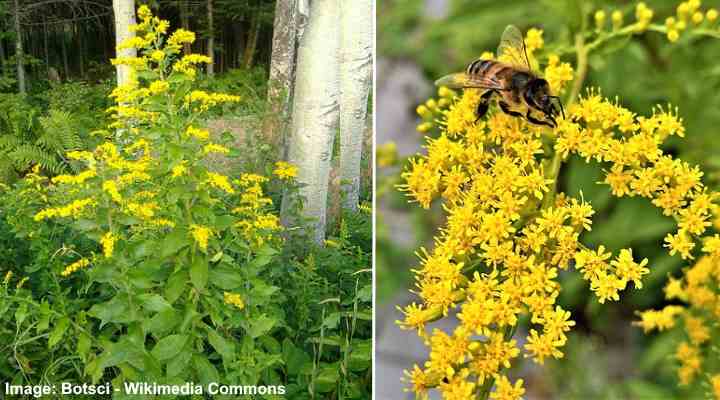
Wrinkleleaf goldenrod is a native perennial plant that produces arching cylindrical clusters of golden yellow flowers. The small yellow flowers are full of pollen and nectar that support a range of small bees, wasps, and native butterflies. The yellow-flowering, clump-forming perennial grows 3 to 5 ft. (1 – 1.5 m). Its bloom time is from late summer until fall when it attracts pollinating bees to gardens.
Wrinkleleaf goldenrod is a low-maintenance plant suitable for growing in borders, cottage gardens, or foundation plantings. You can plant the yellow-flowering shrub-like plant in full sun and well-drained to wet soils. Wrinkleleaf goldenrod is cold-hardy in USDA zones 4 through 8.
Bee Balm (Monarda)
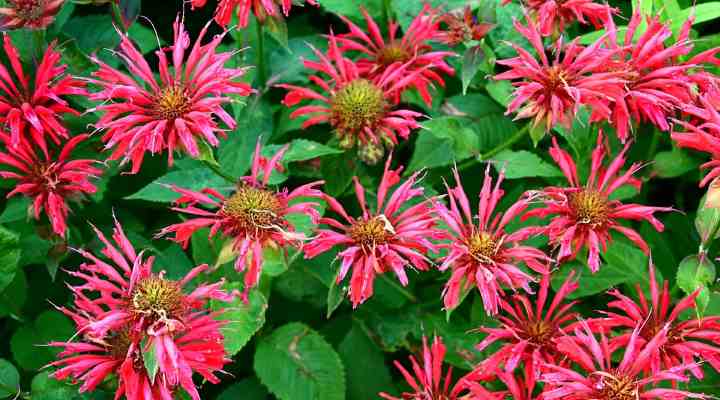
Bee balm is a favorite flower of bees due to its sweet nectar. The summer-blooming showy flowers are red, pale lilac, or purple, with globular flowerheads of wiry petals blooming at the ends of erect stems. This low-growing compact perennial is ideal for informal borders, mass planting, or growing in containers.
In addition to being a food source for bees, bee balm is a lovely ornamental flower that works well in sunny or partially shaded gardens. The flowering stems grow 10” to 12” (25 – 30 cm) tall in moist, fertile soils.
Phlox — Creeping Phlox and Garden Phlox
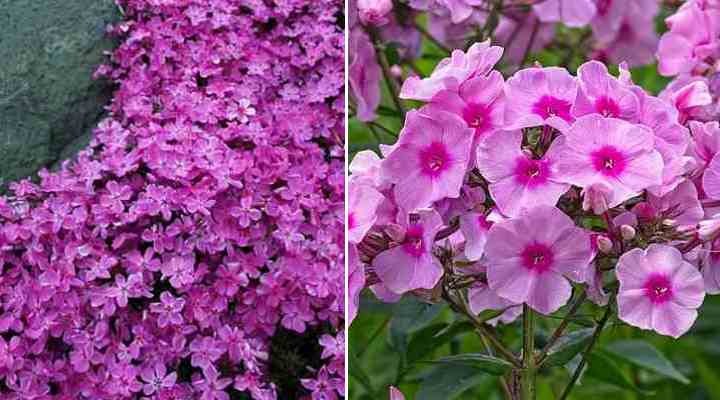
Left image: Creeping phlox (Phlox subulata). Right: Garden phlox (Phlox paniculata)
Creeping phlox and garden phlox are both excellent flowers for bee gardens. Native to the United States, phlox flowers are known for their pink or rosy-lavender clusters, plenty of nectar, and ability to attract hummingbirds, butterflies, and various species of bees. Depending on your bee garden landscaping needs, you can plant ground-hugging phlox or perennial phlox.
Creeping phlox is suitable as a purple-flowering ground cover plant in bee-friendly gardens. The mat-forming perennial spreads quickly over the ground or cascades over retaining walls. The purple star-shaped flowers thrive in full sun or shade in USDA zones 4 to 8.
Garden phlox is an upright, low-maintenance perennial plant with large conical clusters of pink or pale purple bee-friendly flowers. The flowering stems grow 2 to 4 ft. (0.6 – 1.2 m) tall. Garden phlox is cold-hardy in USDA zones 4 to 8 and prefers full sun in moist soils.
Sunflower (Helianthus annuus)

Sunflowers are a fantastic flowers in bee gardens because they are an excellent source of nectar and pollen for bees. These lovely ray flowers grow up to 10 ft. (3 m) high, making them great for creating a natural border in a bee-friendly garden or as a focal point in a flower bed.
Sunflowers are popular with native pollinators because the large central chocolate-colored nectar-filled disks provide an abundant food source for bees and butterflies. Additionally, sunflowers have healing properties for honeybees and wild bees affected by parasites.
Aster
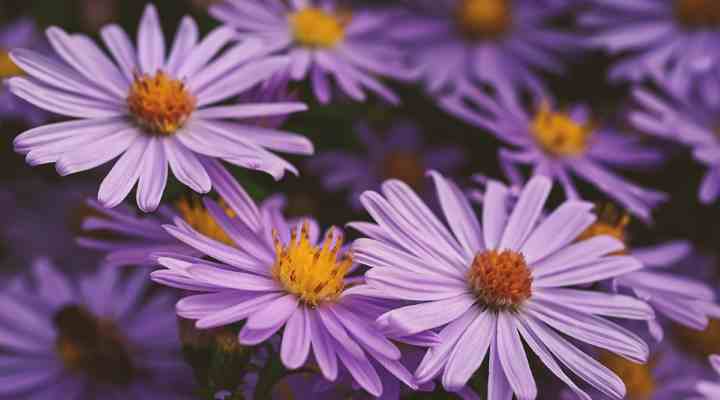
Asters are a group of daisy-like flowers that are a favorite with honeybees, bumblebees, and wild bees. The ray flowers come in various colors, including pink, purple, blue, and white, most of which have yellow centers. Depending on the variety, asters grow 1 to 3 ft. (0.3 – 1 m) tall and thrive in full sun.
Asters bloom in late summer and fall, providing a late-season food source for bees before winter. The bee-friendly flowers also add a pop of color to mixed borders, butterfly gardens, containers, and flowerbeds. In addition, the small nectar-filled centers ensure that tiny species of bees can also collect food.
Asters are suitable for growing in USDA zones 4 to 8.
Lantana

Lantana is a group of heat-tolerant deciduous shrubs with clusters of colorful tropical flowers that attract black and yellow honeybees and other pollinators. This plant produces clusters of tubular flowers in pink, red, orange, and yellow hues. Lantanas bloom from late spring to early summer, which is ideal for bee gardens by providing a reliable source of nectar for the buzzing insects throughout the season.
Lantana shrubs grow 1 to 2 ft. (0.3 – 0.6 m) tall. The rounded or flat-topped flower clusters provide a large landing pad for various bee species. The fragrant flowers add a splash of bright color to southern gardens, followed by deep purple-black berries.
Joe-Pye Weed (Eutrochium purpureum)
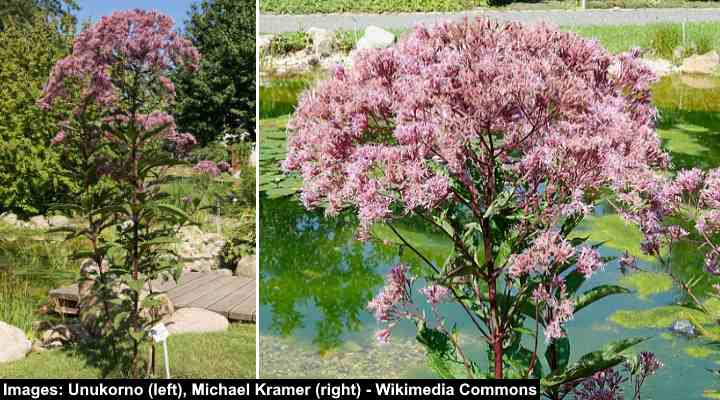
The spectacular flower clusters of Joe-Pye weed are excellent for attracting bees to gardens throughout North America. The native perennials have rich pink-purple flowers blooming in mid-summer through early fall. In addition, the nectar-containing flowers provide a valuable food source for bees and other pollinators.
Joe-Pye weed prefers full sun or partially shaded areas with well-drained soil. The ornamental shrub grows 5 to 7 ft. (1.5 – 2.1 m) tall, making it a great border plant, foundation planting, or mixed perennial flower beds in bee gardens.
The Best Flowering Herbs For Bees
Herbs are often overlooked when planting bee gardens. However, various types of flowering herbs have the qualities to attract bees—purple flowers and aromatic scents. Here are a few of the best flowering herbs for bees.
Lavender (Lavandula)

English lavender (Lavandula angustifolia)
Lavender is one of the best flowering herbs for bee gardens. It has spikes of fragrant purple flowers that many species of bees love. Growing 2 to 3 ft. (0.6 – 1 m) tall, bee-friendly lavender is ideal for growing in borders, along walls, in rock gardens, and as informal edging.
Lavender thrives in USDA zones 5 to 8 in well-draining soil and full sun. In addition to being an important food source for bees, lavender is an aromatic ornamental flower for herb gardens.
Oregano (Origanum vulgare)

Oregano is an attractive aromatic flowering herb for bee gardens. The small woody perennial has tiny pink-purple or white flowers that bloom from mid-summer through fall. These fragrant blooms provide a plentiful source of sweet nectar for honeybees, carpenter bees, bumblebees, and leafcutter bees.
Oregano is a perennial culinary herb that thrives in well-draining soil and full sun. In addition to enticing bees to your garden, oregano performs well as a border plant. Also, its aromatic leaves are a staple ingredient of Mediterranean cuisine.
Oregano thrives in USDA zones 4 to 8 and grows 1 to 3 ft. (0.3 – 1 m) tall.
Rosemary (Rosmarinus officinalis)

Rosemary is an aromatic evergreen shrub with small purple flowers that attract bees. Identifying features of rosemary are its small clusters of blue, purple, or white flowers and aromatic needle-like leaves growing on erect woody stems. Bee-loving rosemary flowers grow 2 to 6 ft. (0.6 – 1.8 m) tall.
The fragrant flowers on rosemary shrubs are a great food source for a wide range of bee species from spring through fall. In a bee garden, rosemary performs well as an ornamental shrub in inland or coastal gardens, as ground cover in full sun, or in an aromatic herb garden.
Sage (Salvia)

Sage is an attractive, aromatic flowering herb popular in bee-friendly gardens. The alluring feature of sage is its attractive purple flower spikes that bloom from late spring through early fall. These bee-loving flowers provide a source of sweet nectar for various bee species.
Sage prefers well-drained soil and full sun or partial shade. Its low growth makes it a perfect border plant in a herb garden or bee-friendly landscape. Additionally, you can plant sage for its attractive blooms, fragrant edible leaves, or as an ornamental feature in containers or border plantings.
The Best Flowering Trees for Bees
It’s good to remember that flowering ornamental trees are important for bee gardens. Flowering trees provide a much-needed food source for all kinds of bee species throughout the year. In addition, bee-friendly trees enhance your yard’s aesthetics and provide shade in hot summer conditions.
Magnolia Tree (Magnolia grandiflora)
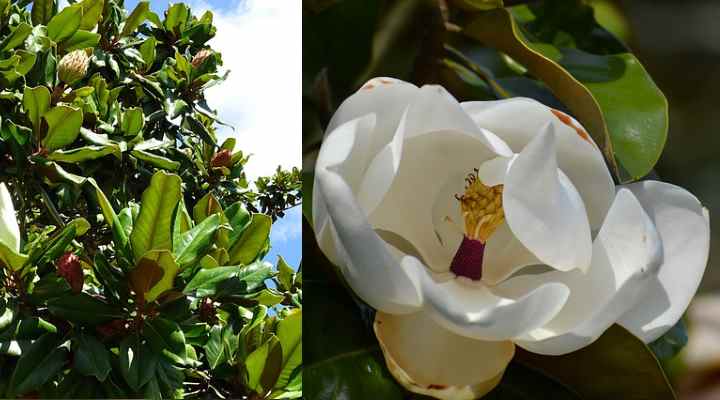
Magnolia is a stunning white-flowering tree, perfect for enticing bees to your front or backyard. Evergreen magnolia trees are identified by their fragrant cup-shaped creamy-white blooms, leathery leaves, and large rose-red cone-like seed pods. Magnolia trees grow 60 to 80 ft. (18 – 24 m) tall and up to 50 ft. (15 m) wide.
Magnolia trees and shrubs add beauty and shade to a garden landscape. In addition, its abundance of nectar-filled flowers ensures a wide range of bee species have enough food. Magnolias thrive in USDA zones 7 through 10.
Fruit Trees

A bee on a cherry blossom
The pink and white blossoms of various varieties of fruit trees attract bees during spring. Apple, cherry, plum, and pear trees are covered with small, fragrant bowl-shaped flowers. The dainty flowers are ideal for feeding any species of bee, large or small.
Redbud Tree (Cercis canadensis)
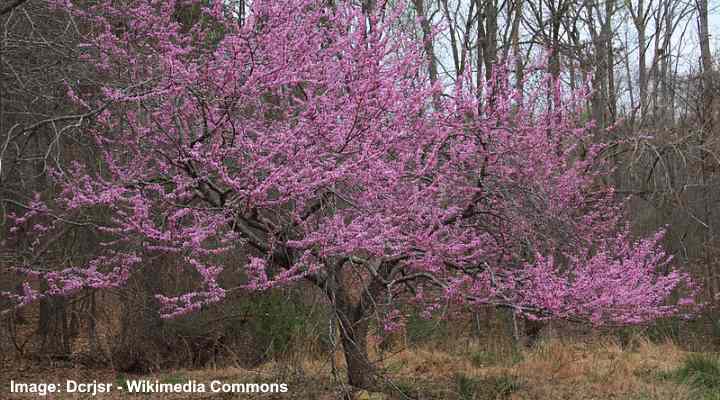
The redbud tree is a beautiful ornamental native tree with stunning pink spring flowers that allure various bee species to gardens. The eye-catching feature of redbud trees is their early-blooming pink to purple flowers on bare branches. These provide a vital early source of nectar and pollen sources for early-season bees.
The redbud tree with stunning pink spring flowers grows 20 to 30 ft. (6 – 9 m) tall and up to 35 ft. (10.5 m) wide, making it an ideal landscaping tree for small front or backyard spaces. Additionally, the tree has heart-shaped leaves and brown, bean-like seed pods. The tree’s dense foliage turns pale yellow in the fall, adding beautiful colors late in the season.
Black Locust Tree (Robinia pseudoacacia)
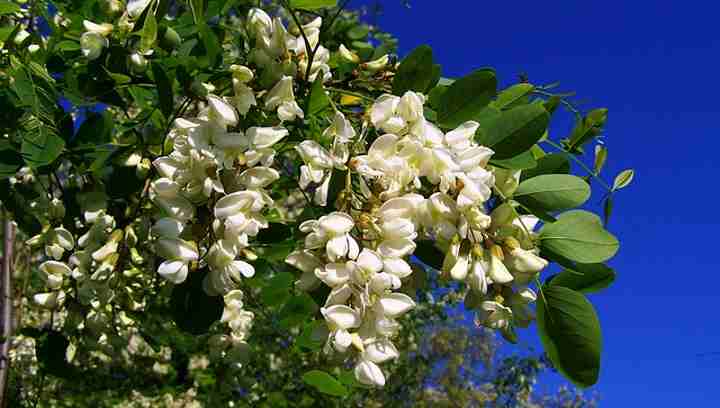
Black locust tree flowers
The black locust tree is a great addition to any bee garden because of its long-lasting, cascading clusters of fragrant white flowers. Black locust trees have attractive compound leaves with oval leaflets, white flowers, and purplish-brown seed pods. Thriving in full sun, this attractive shade tree grows 30 to 50 ft. (9 – 15 m) tall.
Blooming in late spring, black locust trees are a perfect nectar and pollen source for bees. In addition, the tree’s ornamental clusters of pendulous flowers add color to spring and summer landscapes.
Flowering Dogwood (Cornus florida)
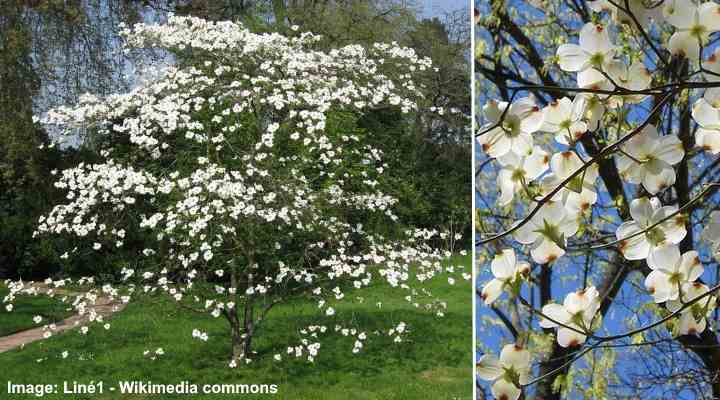
Flowering dogwood is a beautiful small ornamental tree with features necessary for bee gardens. Spectacular white flowers adorn its horizontal branches in spring and summer before giving way to red berries. The early-blooming white or pink blossoms provide a plentiful nectar source for various bee species.
This deciduous flowering dogwood tree has several ornamental features for partially shaded yards. Its four-season interest comes from its oval leaves that turn red in the fall, orange-red summer fruits, and white flowers. Additionally, its alligator skin-like bark provides winter interest.
Many gardeners rate white-flowering dogwoods as the best small trees for bee and pollinator gardens.
Discover the most beautiful types of bees and learn how to identify them.
Related articles:
